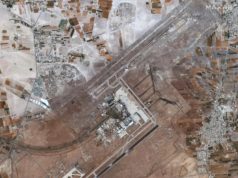For the first time under Asad family rule, the Syrian government is experiencing the kind of unrest that unseated the decades-long rulers of Tunisia and Egypt and threatens Libya’s Muammar Qaddafi.
Anti-government demonstrations began mid-March in Syria’s southern city of Daraa after 15 children were arrested for spray-painting walls with words that have recently rattled the Arab world: “The people want the fall of the regime.” Thought to be contained, the protests have now spread across the country, including to the capital city of Damascus and to Hama, where Syrian security forces massacred thousands in 1982.
Syrian President Bashar al-Asad has responded to the protests with brutal repression. According to human rights activists and witnesses, over 100 people have been killed by police gunfire in the city of Daraa alone.

A government building destroyed by protesters in Daraa, Syria |
In an effort to quell the uprisings, Syria’s government resigned Tuesday. But if that move calmed tensions at all, Asad further angered protesters on Wednesday when he gave his first speech since the uprisings began. That speech was expected to offer significant political concessions but did nothing of the sort; Asad instead took the time to claim that the uprisings were the result of “a big plot from outside” and said nothing about ending the emergency law that has stifled Syrians for the last 48 years.
The U.S. should take this opportunity to lead the European Union in applying more pressure on the Asad regime. Unlike Libya, Syria is actively and currently working against American interests in the region. From building nuclear reactors, supporting Hezbollah and Hamas, partnering with Iran, assassinating political rivals at home and abroad, and choking Lebanon, the time has come for Asad and company to face the music. The White House should begin by recalling its recently appointed ambassador.





